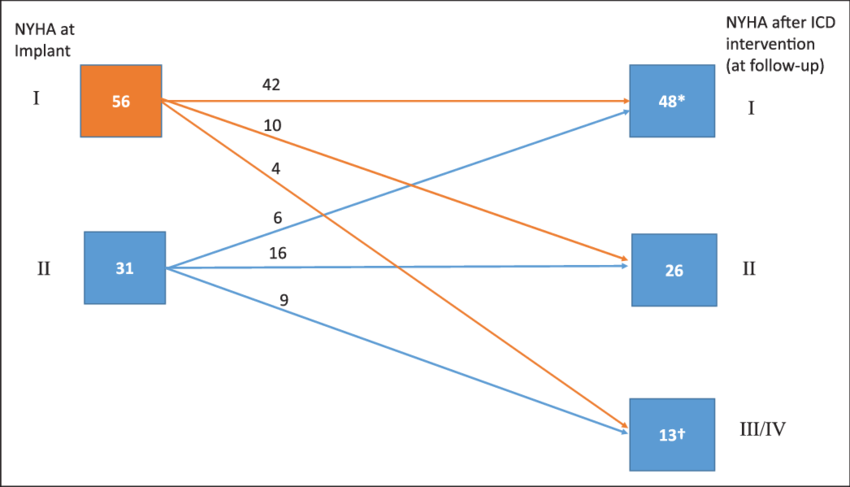The New York Heart Association (NYHA) Classification is a system used by healthcare professionals to assess the severity of heart failure in patients. This classification is crucial in guiding treatment decisions and understanding a patient’s functional limitations. In this article, we will explore the NYHA classification in detail, discussing its history, categories, significance, and its role in managing heart failure.
1. Introduction to the NYHA Classification
The NYHA classification system is essential in the field of cardiology. It provides a standardized method for healthcare professionals to evaluate the functional capacity of patients with heart failure. By understanding how heart failure impacts a patient’s ability to perform daily activities, doctors can make informed decisions about treatment and management strategies.
Heart failure is a serious condition that affects millions of people worldwide. It occurs when the heart is unable to pump sufficient blood to meet the body’s needs, leading to symptoms such as fatigue, shortness of breath, and swelling. The NYHA classification helps to categorize patients based on their symptoms and limitations, allowing for tailored treatment approaches.
2. History of the NYHA Classification
The NYHA classification system was established in 1920 by the New York Heart Association. The need for a standardized approach to classify heart failure was evident, as clinicians required a reliable method to communicate the functional status of patients. The classification has since evolved and has become a widely accepted tool in both clinical practice and research.
Initially, the classification had only three classes, but it was expanded to four classes in 1971 to provide more detailed descriptions of heart failure severity. This expansion allowed healthcare providers to better assess the functional limitations experienced by patients and to monitor changes in their condition over time.
3. The Four Categories of the NYHA Classification
The NYHA classification consists of four distinct categories, each representing a different level of functional impairment due to heart failure. Understanding these categories is vital for both patients and healthcare providers.
Class I: No Limitation of Physical Activity
Patients in Class I experience no limitation in physical activity. They can engage in ordinary activities without experiencing symptoms such as fatigue, shortness of breath, or palpitations. This class represents a mild stage of heart failure, where individuals can maintain a normal lifestyle with no restrictions.
Characteristics of Class I:
- No symptoms during physical activity
- Normal physical activity is possible
- Often unaware of any heart condition
Class II: Slight Limitation of Physical Activity
Class II patients exhibit a slight limitation in physical activity. While they are comfortable at rest, they may experience symptoms such as fatigue or shortness of breath during ordinary activities. This class indicates a moderate level of heart failure, requiring patients to be more cautious with physical exertion.
Characteristics of Class II:
- Symptoms occur with normal activity
- Patients can carry out daily activities with some effort
- May need to take breaks during exertion
Class III: Marked Limitation of Physical Activity
Patients classified as Class III have a marked limitation in physical activity. They are comfortable at rest but experience significant symptoms when engaging in even mild physical activity. This class reflects more advanced heart failure, where patients must significantly modify their lifestyle.
Characteristics of Class III:
- Symptoms occur with less than ordinary activity
- Patients may struggle with simple tasks like walking or climbing stairs
- Quality of life is impacted due to limitations
Class IV: Inability to Carry on Any Physical Activity
Class IV is the most severe classification of heart failure. Patients in this category are unable to carry out any physical activity without experiencing discomfort. Symptoms may occur even at rest, indicating a critical condition that requires immediate medical intervention.
Characteristics of Class IV:
- Symptoms present at rest
- Any physical activity leads to discomfort
- Patients may require hospitalization or advanced treatment options
4. Importance of the NYHA Classification
The NYHA classification is vital for several reasons:
- Standardization: It provides a common language for healthcare providers, ensuring consistent communication regarding a patient’s condition.
- Treatment Guidance: By understanding a patient’s class, healthcare professionals can tailor treatment plans that address the specific needs of individuals based on their functional limitations.
- Monitoring Progress: The classification system allows for easy tracking of changes in a patient’s condition over time. By assessing whether a patient remains in the same class or progresses to a higher or lower class, doctors can adjust treatment strategies accordingly.
- Research Applications: The NYHA classification is frequently used in clinical trials and research studies to evaluate the efficacy of treatments and interventions for heart failure. It provides a clear framework for assessing outcomes in various populations.
5. Applications of the NYHA Classification in Clinical Practice
In clinical practice, the NYHA classification plays a crucial role in the management of heart failure. It is used to:
- Assess Severity: Upon diagnosis, patients are classified to determine the severity of their condition. This classification informs treatment options and lifestyle modifications.
- Develop Treatment Plans: Depending on the NYHA class, treatment options may vary. For instance, patients in Class I may only require lifestyle changes, while those in Class IV may need advanced therapies such as medications, implantable devices, or surgery.
- Facilitate Patient Education: The NYHA classification helps healthcare providers explain the nature of the condition to patients. Understanding their classification can empower patients to take an active role in managing their health.
- Guide Follow-Up Care: Regular follow-up appointments often include reassessment of the NYHA class to monitor any changes in symptoms or functional capacity. This helps in timely adjustments to treatment plans.
6. Limitations of the NYHA Classification
While the NYHA classification is a valuable tool, it has its limitations:
- Subjectivity: The classification relies on patients’ self-reported symptoms, which can vary based on individual perception and reporting.
- Lack of Objective Measurements: The NYHA classification does not incorporate objective measurements such as exercise testing or imaging studies, which may provide a more comprehensive understanding of a patient’s condition.
- Variability in Patient Responses: Different patients may experience the same NYHA class differently. For example, two Class II patients may have varying degrees of fatigue and activity limitations.
- Focus on Symptoms: The classification primarily emphasizes symptoms rather than underlying physiological changes, which can be important for comprehensive patient management.
7. Conclusion
The NYHA classification is an essential tool for assessing and managing heart failure. By categorizing patients based on their functional limitations, healthcare providers can tailor treatment plans and monitor progress effectively. While it has its limitations, the classification remains a cornerstone in the field of cardiology, guiding clinicians in making informed decisions that ultimately improve patient outcomes.
As heart failure continues to affect millions globally, understanding the NYHA classification is vital for patients and healthcare providers alike. By recognizing the significance of this classification system, we can better support individuals living with heart failure and enhance their quality of life.
8. References
- New York Heart Association. (n.d.). NYHA Functional Classification. Retrieved from [NYHA website]
- Cowie, M. R., & Wood, D. A. (1997). The New York Heart Association classification: a simple guide for assessing the functional status of patients with heart failure. British Medical Journal, 315(7115), 1335.
- Jessup, M., & Brozena, S. (2003). Heart failure. New England Journal of Medicine, 348(20), 2007-2018.
This comprehensive overview of the NYHA classification provides essential insights into its structure, importance, and application in clinical practice. The information contained within aims to empower readers with a clearer understanding of heart failure management and its implications for patient care. If you have any more specific topics or aspects you’d like to explore further, feel free to ask!













